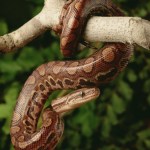Photo of a Wagler's pit viper By Gunawan Kartapranata (Own work) [CC BY-SA 4.0 (http://creativecommons.org/licenses/by-sa/4.0)], via Wikimedia Commons
Platelets are important in the formation of blood clots. For this reason, antiplatelet medications are commonly prescribed for people at risk of developing blood clots, or who have already developed one. Many of the medications that are currently on the market to treat blood clots come with a risk for excessive bleeding and reduced platelet numbers. Researchers have now discovered an effective antiplatelet protein in snake venom that is not…
snake
I came across this neat press release from the American Physiological Society which describes new research on understanding how the genes of burmese pythons are actually altered by feeding. Fascinating! The research was published in the May issue of Physiological Genomics. Here is a brief synopsis. For the full story, visit the APS website.
Yep, that's a python eating a rodent.
What is so fascinating about Burmese pythons is that their body literally is reconstructed within 3 days of eating resulting in the doubling or organ size and a 10-44 fold increase in metabolism. Then, within about…
Image from the American Physiological Society's website.http://www.the-aps.org/mm/Conferences/APS-Conferences/2014-Conferences/…
As anticipated, the meeting today was excellent! Here are some highlights from today:
Dr. Michael Joyner (Mayo Clinic) spoke about how we should reconsider animal models that are used in research as laboratory rodents can be manipulated to match their genotype to their phenotype. In other words, researchers modify the animal's genome to produce a specific disease or attribute they are interested in studying. The problem with this approach is that genes can be…
Image from the American Physiological Society's website.http://www.the-aps.org/mm/Conferences/APS-Conferences/2014-Conferences/…
I am really excited about the comparative physiology conference that starts this weekend in San Diego! Here is a press release about the meeting (author Stacy Brooks from the American Physiological Society):
Bethesda, Md. (September 25, 2014) — More than 400 comparative and evolutionary physiologists will gather to present new research and discoveries in animal physiology at the American Physiological Society’s 2014 intersociety meeting “Comparative Approaches to…
Image of a green tree python from www.kids.britannica.com J.H. Pete Carmichael—The Image Bank/Getty Images
Dr. Greg Byrnes (Siena College, Loudonville, NY) and Dr. Bruce Jayne (University of Cincinnati, OH) discovered that snakes use more force than is necessary to support their weight when climbing. To climb, snakes rely on friction and repeatedly contract and extend their bodies, a process called concertina locomotion. To study the forces generated by snakes during this type of locomotion, the researchers constructed a vertical cylinder that was covered with textured tennis racket tape…
This past weekend, I was searching around the interwebz looking for something interesting to write about for Monday Pets. Lately, Monday Pets has been somewhat cat- and dog-heavy, so I was looking for something a bit different. I asked on twitter if there were any requests or recommendations. Friend of the blog Dave Munger responded: "What about snakes?"
What about snakes indeed? There are many parallels between myself and Indiana Jones, but one big one is that we both hate snakes. Another similarity is whenever I travel by plane, I leave a series of red dashes to mark my path. We both look…
I find the music in this video to be completely appropriate.
Below the fold is a description the nice communications lady at the CA Academy sent me...interesting stuff. By the way, if you haven't been to the California Academy of Sciences you are missing out on one of the most state of the art museums in the world.
"At feeding time in the California Academy of Sciences' vine snake exhibit, one blink and you might miss the action. These pencil-thin snakes hunt fish swimming in the water below, striking with lightning speed. We recently captured a feeding on film (http://www.youtube.com/…
Take a whiff of mustard or wasabi and you'll be hit with a familiar burning sensation. That's the result of chemicals in these pungent foods hitting a protein called TRPA1, a molecular alarm that warns us about irritating substances. The same protein does a similar job in other animals, but rattlesnakes and vipers have put their version of TRPA1 to a more impressive and murderous purpose. They use it to sense the body heat of their prey.
Pit vipers are famed for their ability to detect the infrared radiation given off by warm-blooded prey, and none more so than the western diamondback…
Snakes have been around for nearly 100 million years and scientists have found many fossils of extinct species. But this astonishing specimen is different. This serpent is Sanajeh indicus. It is sitting in a dinosaur nest and its coils surround three eggs and the body of a hatchling.
There are many reasons to think that this prehistoric tableau represented a predator caught in the act of hunting, rather than a mash-up of unconnected players thrown together by chance. The snake is perfectly posed, with its head resting atop a coil and its body encircling a crushed egg. All the pieces are…
Yup, that's a flying bat gripping a lamp in its mouth, with his buddy, a coiled snake, crawling along above him. And it's not a faux-Victorian, nouveau-Goth creation - it's a replica of an actual late 1800s fixture, by eclectic lighting company Rejuvenation. Seriously - over a hundred years ago, someone thought this was the greatest lamp evah! I'm not sure I'd actually choose the Dracula-esque Drake fixture for myself, mind you; not only is it more than $2K, I think you need a very special space for this 45" long creation. Like a living room designed by Edward Gorey. But if you've got that…
While anacondas and pythons, the largest known snakes alive today, can reach over 30 feet long and swallow antelope whole, they are dwarfed in size by the newly discovered Titanoboa cerrejonensis, a serpent that lived during the Paleocene epoch whose bones were unearthed recenty in a Colombia coal mine. By analyzing the snake's vertebrae, paleontologists were able to determine that Titanoboa measured over 42 feet long and weighed more than 1.3 tons—nearly 30 times the mass of an anaconda.
Related ScienceBlogs Posts:
Titanoboa - thirteen metres, one tonne, largest snake ever..
Titanoboa!
Now…
This is sure to be one of the most amazing scientific images of the year. You're looking at vertebrae from two species of snake. The smaller model on the left belongs to the anaconda, a giant serpent that can grow to 7 metres in length and weigh as much as 45kg. It's arguably the largest snake alive, so just think about how big the owner of the fossilised vertebra on the right would have been! There's a good reason why this new discovery - the largest snake that ever slithered - has been named Titanoboa.
Titanoboa cerrejonesis is new to science and was discovered by a team of North…
Don't know the background here. Not for those with weak stomachs, pretty incredible though.
Penn State University biologist Blair Hedges seems to have found his niche: identifying the world's tiniest reptiles and amphibians. Having already found world record holders for the smallest lizard and frog, Hedge's has announced the discovery of the world's smallest snake, Leptotyphlops carlae, which grows to only four inches long. Commonly known as the Barbados Thread Snake, the little guy is about .2 inches shorter than the previous record holder, which is native to Martinique.
Hedges believes this wimpy reptile may be the minimum size for a snake. The snake is blind and lays a single,…
As you can see, this specimen of Leptotyphlops carlae is small enough to hang out on a US quarter. Scientists are still working out why this snake associates itself with coinage.
But seriously, this snake was discovered by Blair Hedges, an evolutionary biologist at Pennsylvania State University, who is famous for also having discovered the world's smallest gecko in 2001 and the world's smallest frog in 1993 .
How does he do it?
According to Hedges, it is mostly a matter of luck.
"I turned a small rock and found it hiding underneath," he claimed in a recent press report. However, the…
A new study by American and German scientists, published in the Physical Review Letters, has shed light on a classic zoological mystery: how do snakes hear?
For quite a while, researchers did not believe that snakes could hear, until tests performed in the 1970's proved otherwise. Still, those tests did not explain how the snakes managed to pick up sound. "They ain't got no ears," one prominent snake-eologist from Hope, Arkansas was noted to say. As later studies revealed, they actually do have ears, but a study released this week shows a second way for them to register noise, using their…
tags: reptile, snake, photography, subway art, AMNH, NYC, NYCLife
Is this a rainbow snake, Farancia erytrogramma?
Snake, as portrayed in tiles on the walls of the NYC uptown subway stop (A-B-C)
at 81st and Central Park West. (ISO, no zoom, no flash).
Image: GrrlScientist 2008. [wallpaper size].
Read more about the AMNH tile artworks and see the AMNH tile artworks photographic archives -- with all the animals identified.
Update: This snake was actually discovered by Roygan Taylor working for Bio-Ken in Kenya. He has his own fantastic blog, which in addition to providing a lot of fascinating information about the enormous snake in question, covers all sorts of other interesting snake related issues in Africa. Check it out here http://www.wildlifedirect.org/blogAdmin/savingsnakes
Researchers have identified a new species of spitting cobra in Kenya, one that is over nine feet long and has enough venom to "kill twenty people" according to an "expert" on the subject in this article on nationalgeographic.com.
I'm…
We were sent a link to this vid by a promotions guy working for National Geographic hoping we would bring some grass roots attention to a new show they have coming up. Well we will, but only because it's great watching this moron get what he deserves.
Hopefully we will see more of Brady Barr getting bitten in the future on National Geographic's new show, Dangerous Encounters.
Fascinating footage taken with time lapse photography...
A hapless tree teeming with squirrels...
Doomed lemmings... kind of looks like they're running off a Marshmellow Peep
Nail Fungus
Yes, those are sleep fungi underneath the nail
More great footage here or buy your own here at the Mochimochi store.



